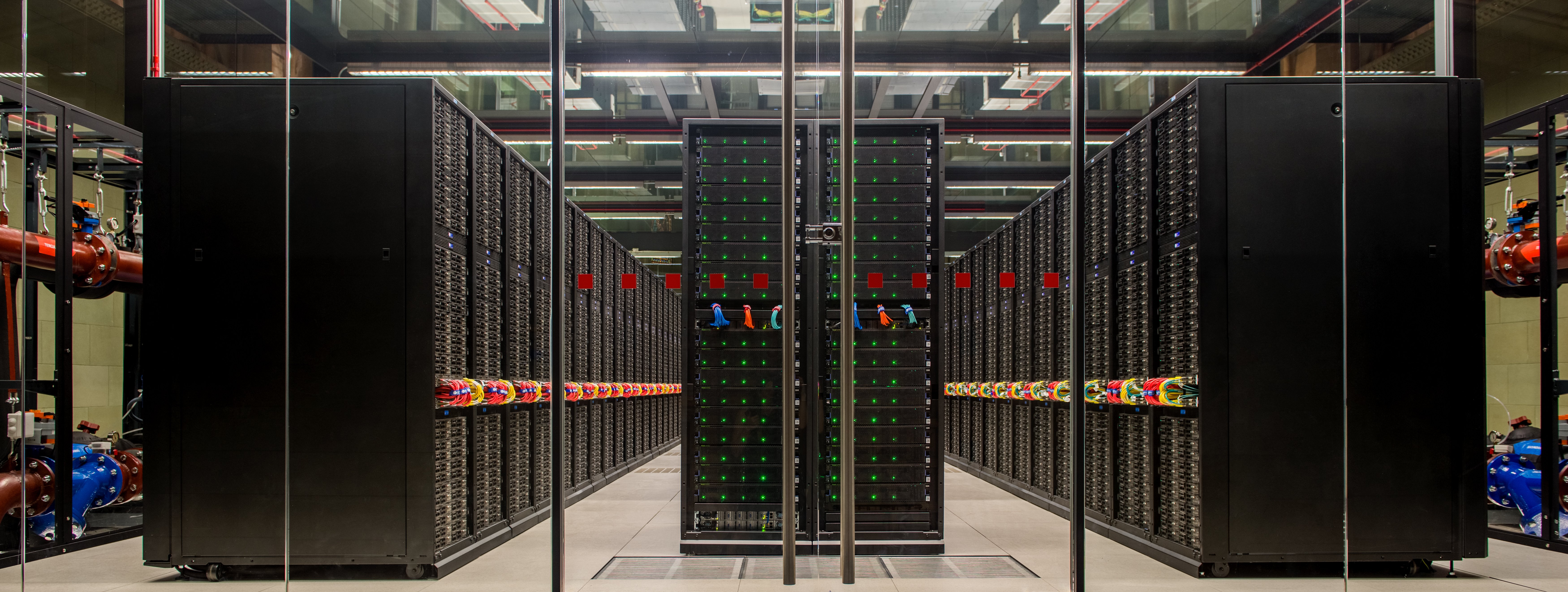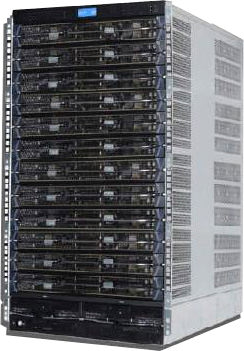
MareNostrum4 (2017) System Architecture
MareNostrum is a supercomputer based on Intel Xeon Platinum processors, Lenovo SD530 Compute Racks, a Linux Operating System and an Intel Omni-Path interconnection.
See below a summary of the general purpose cluster system:
- Peak Performance of 11.15 Petaflops
- 384.75 TB of main memory
- 3,456 nodes:
- 2x Intel Xeon Platinum 8160 24C at 2.1 GHz
- 216 nodes with 12x32 GB DDR4-2667 DIMMS (8GB/core)
- 3240 nodes with 12x8 GB DDR4-2667 DIMMS (2GB/core)
- Interconnection networks:
- 100Gb Intel Omni-Path Full-Fat Tree
- 10Gb Ethernet
- Operating System: SUSE Linux Enterprise Server 12 SP2
MareNostrum4 user documentation

Compute racks
MareNostrum4 has 48 racks dedicated to calculations. These racks have a total of 165,888 Intel Xeon Platinum cores with a frequency of 2.1 GHz and 384.75 TB of total memory.
In total, each rack has 3,456 cores and 6,912 GB of memory.
The peak performance per rack is 226.80 Tflops, and a peak power consumption of 33.7 kW.
Each Lenovo SD530 compute rack is composed of:
- 72 Lenovo Stark compute nodes
- 2 Lenovo G8272 Switches
- 3 Intel OPA 48 port edge switch
- 4 32A 3 phase switched and monitored PDUs

Compute node
The compute nodes are based on the last generation Intel Xeon Platinum technology, and they offer high performance, flexibility and power efficiency. You can see below a description of one node:

Intel Omni-Path rack
The 3,456 compute nodes are interconnected through a high speed interconnection network: Intel Omni-Path (OPA). The different nodes are interconnected via fibre optic cables and Intel Omni-Path Director Class Switches 100 Series.
Six of the racks in MareNostrum are dedicated to network elements which allow to interconnect the different nodes connected to the OPA network.
The main features for the Omni-Path Director Class Switch are:
- Up to 786 x 100GbE ports in 20U (+1U Shelf)
- 12 x hot swap PSUs (N+N)
- Hot swap fan modules
- 2 x Management modules
- 8 x Double spine modules (non-blocking)
- Up to 24 x 32 port leaf modules (20 occupied – 640 ports)
- Each leaf modules contain 2 ASICs
- 9.4kW power consumption
MN4 CTE-POWER System Architecture
MN4 CTE-POWER is a cluster based on IBM Power9 processors, with a Linux Operating System and an Infiniband interconnection network. Its main characteristic is the availability of 4 GPUs per node, making it an ideal cluster for GPU accelerated applications.
It has the following configuration:
- 2 login node and 52 compute nodes, each of them:
- 2 x IBM Power9 8335-GTH @ 2.4GHz (3.0GHz on turbo, 20 cores and 4 threads/core, total 160 threads per node)
- 512GB of main memory distributed in 16 dimms x 32GB @ 2666MHz
- 2 x SSD 1.9TB as local storage
- 2 x 3.2TB NVME
- 4 x GPU NVIDIA V100 (Volta) with 16GB HBM2.
- Single Port Mellanox EDR
- GPFS via one fiber link 10 GBit
The operating system is Red Hat Enterprise Linux Server 7.5 (Maipo).

MN4 CTE-ARM System Architecture
MN4 CTE-ARM is a cluster based on Fujitsu FX1000 machine, with a Linux Operating System and a Tofu interconnection network. Its main characteristic is the availability of ARM v8 chip per node. This machine is identical to the bigggest machine in the world, Fugaku Supercumputer in the top500 list of November-2020.
It has the following configuration:
- There are 2 login nodes and 192 computing nodes.
- The login nodes have the CPU Intel(R) Xeon(R) Silver 4216 CPU @ 2.10GHz and 256 GB of main memory. They are used for Cross-compilation for the compute nodes that uses ARM processors.
- Each computing node has the following configuration:
- A64FX CPU (1 Armv8.2-A + SVE chip) @ 2.20GHz ( grouping the cores in 4 CMG - Core Memory group - with 12 cores/CMG and an additional assistant core per CMG for the Operating system, adding a total of 48 cores + 4 system-cores per node.
- The ARMv8.2-A cores have available the Scalable Vector Extension (SVE) SIMD instruction set up to 512-bit vector implementation.
- 32GB of main memory HBM2
- TofuD network
- Single Port Infiniband EDR ( only few nodes to export the FEFS filesystem)
- A64FX CPU (1 Armv8.2-A + SVE chip) @ 2.20GHz ( grouping the cores in 4 CMG - Core Memory group - with 12 cores/CMG and an additional assistant core per CMG for the Operating system, adding a total of 48 cores + 4 system-cores per node.
MN4 CTE-AMD System Architecture
MN4 CTE-AMD is a cluster based on AMD EPYC processors, with a Linux Operating System and an Infiniband interconnection network. Its main characteristic is the availability of 2 AMD MI50 GPUs per node, making it an ideal cluster for GPU accelerated applications.
It has the following configuration:
- 1 login node and 33 compute nodes, each of them:1 x AMD EPYC 7742 @ 2.250GHz (64 cores and 2 threads/core, total 128 threads per node)
- 1024GiB of main memory distributed in 16 dimms x 64GiB @ 3200MHz
- 1 x SSD 480GB as local storage
- 2 x GPU AMD Radeon Instinct MI50 with 32GB
- Single Port Mellanox Infiniband HDR100
- GPFS via two copper links 10 Gbit/s


